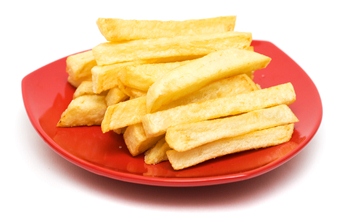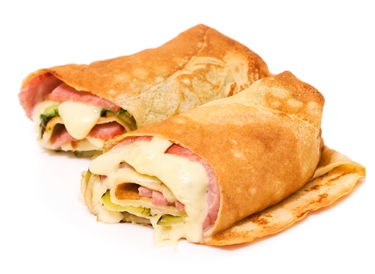
We are genetically programmed to eat until the sensation of "fullness" sets in—a complex response
involving blood sugar levels, brain chemicals, and other biological factors, aided by tiny "stretch receptors" in the stomach that signal the brain when its capacity has been reached. The human stomach is a pouch about the size of a clenched fist. Most people assume it to be larger, but normally it isn't. However, the stomach will stretch in size if we continually cram it with food. When this happens, the stomach requires ever-increasing amounts of food to trigger the stretch receptors that signal fullness. But this overeating isn't the main reason we become overweight, because it isn't how much food we pack into our stomachs that causes the problem, but rather the kind of food. Calories, not the volume, are the real culprit. This is an important distinction, and understanding it is the single most important key to controlling your weight, or slimming down. Ounce for ounce, modern processed foods contain far more calories than anything found in nature. They are loaded with extra fat, which contains more than twice as many calories per gram as carbohydrates and protein. Many commercial foods also contain added sweeteners in the form of high-fructose corn syrup, a highly concentrated source of calories. We also eat loads of refined, calorie-dense carbohydrates such as breads, cookies, cakes, crackers, and candies, to name just a few of the popular foods that pack an enormous amount of calories into a few bites.
brain chemicals, and other biological factors, aided by tiny "stretch receptors" in the stomach that signal the brain when its capacity has been reached. The human stomach is a pouch about the size of a clenched fist. Most people assume it to be larger, but normally it isn't. However, the stomach will stretch in size if we continually cram it with food. When this happens, the stomach requires ever-increasing amounts of food to trigger the stretch receptors that signal fullness. But this overeating isn't the main reason we become overweight, because it isn't how much food we pack into our stomachs that causes the problem, but rather the kind of food. Calories, not the volume, are the real culprit. This is an important distinction, and understanding it is the single most important key to controlling your weight, or slimming down. Ounce for ounce, modern processed foods contain far more calories than anything found in nature. They are loaded with extra fat, which contains more than twice as many calories per gram as carbohydrates and protein. Many commercial foods also contain added sweeteners in the form of high-fructose corn syrup, a highly concentrated source of calories. We also eat loads of refined, calorie-dense carbohydrates such as breads, cookies, cakes, crackers, and candies, to name just a few of the popular foods that pack an enormous amount of calories into a few bites.
One of the most extreme examples of these calorieconcentrated foods is what we have come to call fast food— a greasy hamburger topped with cheese, slathered with mayonnaise-based sauce, and sandwiched between a big bread bun. This is a meal unto itself; but it is frequently served with a side of deep-fat-fried french fries and a soft drink that can contain the equivalent of 40 teaspoons of sugar. By the time your stomach signals it is full from the physical volume of one of these calorie-intense meals, you could have easily consumed 1,200 calories or more. This is nearly twice as many calories as the body can put to immediate use, so the excess is converted into fat and stored away in your fat cells. Just one meal like this contains nearly all the calories needed by the average female, whose intake shouldn't exceed 1,800 calories per day if she doesn't want to gain weight. Add to this a breakfast, a sit-down dinner, a few snacks, and another soft drink or two or three, and it's easy to see the enormous impact that a simple fast-food lunch can have on your weight and, ultimately, your health. So here we are, surrounded by an unprecedented abundance of food that is more concentrated in calories than anything humans have ever known. To make matters worse, we are conditioned to eat three meals a day. "Three squares a day" was a necessity back in the days when our forefathers were hardworking farm families. Back then, the average man and woman labored from sunrise to sunset—the equivalent of running ten miles a day—requiring as many as 5,000 calories a day.
Sedentary Lifestyle
Today, we perform much less physical labor, but the habit of eating three daily meals prevails. Our bellies have grown accustomed to feeling full; in fact, many of us feel a vague "emptiness" when they are not. Cars carry us everywhere, making it easy to miss the physical activity necessary to burn these calories. Many of you who are my age (fifty-nine) can recall walking to school as a child. Of course, that's not the case today. And before the advent of television, kids went outdoors to play baseball, football, tag, and to exhaust themselves on the public playground. Now, our kids mostly play video games, watch TV, and are chauffeured everywhere by parents and school buses. Adults are in a similar bind. Work is more intellectual than manual, and what little leisure time we have is spent recovering from the day's stress on the couch, usually with an ample supply of calorie-packed snack foods. Is it any wonder we are in such poor shape?
Health officials first announced that we had a problem back in the early 1980s. Reacting to the threat of rising rates of obesity, heart disease, and other weight-related conditions, people began jogging, running, biking, swimming, jumping rope, and doing step aerobics. All sorts of hamster-wheel exercise devices were invented. People joined gyms, pumped weights, and became martial artists, rock climbers, kayakers, marathoners, jazz dancers—anything to burn fat and build muscle. America was in the grip of a fitness-and-dieting craze that turned people into fanatics and left them feeling hungry and exhausted. Hundreds of thousands of people today are still running themselves ragged in the pursuit of losing weight. At any given moment—like right now—50 percent of all adults in this country are involved in some type of effort to lose weight. Some are dieting (formally known as calorie restriction, a fancy way of saying "eating less food"). Some are exercising their buns off. Some have joined national weight-loss organizations. Some drink exotic beverages or pop pills and supplements that speed up their metabolism, or munch low-calorie energy bars in place of regular meals.
This, of course, makes the diet industry a huge industry. By 2008, it will be worth $61 billion. Why so big? Because there is a lot of repeat business in the weight-loss industry. People hop from fad to fad because so few of these approaches succeed. Research from as far back as the 1950s has found that about 95 percent of all diets fail. While the official failure rate for dieting may not surprise you, this will: Over the past few decades, the American public has been part of a massive experiment. Doctors and selfproclaimed weight-loss experts have been plying us with weight-loss theories that have no real scientific backing. That includes the two most popular crazes of recent times, the low-fat diet and the low-carb diet. Each deserves close scrutiny because millions of people in this country were (and still are) devotees.
What's Wrong about the Low-Fat Craze
The low-fat diet got started in the 1970s. Though this approach was never scientifically proven, it seemed to make sense. Since fat has twice as many calories as carbohydrates or protein, it seemed logical that consuming fatty foods—including fried , red meat, cheese, and other dairy products—was the fast lane to weight gain. Low-fat eating became the rage, and an entirely new category of reduced-fat foods filled supermarket shelves. We had no-fat cookies, fat-free ice creams, low-fat pastries, nonfat milk and cheeses, and on and on. Every food manufacturer was eager to capitalize on this new diet craze. But a curious thing happened. After fifteen years of eating less fat, scientists discovered that Americans hadn't slimmed down at all. In fact, we had grown progressively fatter. During the years when fat consumption was dropping, the weight of the average American adult increased by about 10 pounds. Why? Because Americans, believing that low-fat foods would help them lose weight, ate more of them. It wasn't unusual in those days for an individual to consume an entire box of lowfat cookies in one sitting.
twice as many calories as carbohydrates or protein, it seemed logical that consuming fatty foods—including fried , red meat, cheese, and other dairy products—was the fast lane to weight gain. Low-fat eating became the rage, and an entirely new category of reduced-fat foods filled supermarket shelves. We had no-fat cookies, fat-free ice creams, low-fat pastries, nonfat milk and cheeses, and on and on. Every food manufacturer was eager to capitalize on this new diet craze. But a curious thing happened. After fifteen years of eating less fat, scientists discovered that Americans hadn't slimmed down at all. In fact, we had grown progressively fatter. During the years when fat consumption was dropping, the weight of the average American adult increased by about 10 pounds. Why? Because Americans, believing that low-fat foods would help them lose weight, ate more of them. It wasn't unusual in those days for an individual to consume an entire box of lowfat cookies in one sitting.
"Carbo-mania"
Like everyone else, we were eating less fat, but we were actually taking in more calories from the carbohydrates in these foods than if we had eaten the full-fat versions. So guess what became the next "problem" food group for overweight people? In the late 1980s, carbohydrates became the new dietary demon, ushering in a new era of low-carb eating. Led by Dr. Robert Atkins, America's low-carb guru, our nation embarked on a diet craze that bordered on compulsion. Protein became the new weight-loss "miracle" food, and eating carbohydrate foods such as bread, pasta, white rice, grains, and sugar was tantamount to dietary mortal sin. Dr. Atkins encouraged his followers to eat protein—and lots of it—at every meal. People were having eggs, bacon, and sausage for breakfast, while skipping the fruit, juice, toast, and breakfast cereals. Lunch was a bun-less hamburger, a hunk of cheese, and a tall glass of milk. Dinners consisted of steaks, chops (or both), and maybe a small side of broccoli or a salad with blue cheese or ranch dressing. Restaurants obliged by offering heaps of meat and cutting back on the potatoes.
Even though the medical community soundly criticized the diet as being dangerous to cardiovascular health because of its high saturated fat content (as well as encouraging bone loss and overburdening the kidneys with excessive protein), lowcarb eating spread like wildfire from coast to coast. Given permission to eat all the rich, savory meat and cheese they wanted as a way to lose weight, millions of people jumped on the bandwagon. The food industry wasted no time hopping on board too, creating entire lines of low-carb foods, many of which were endorsed by the suddenly wealthy Atkins corporation. The main attraction, of course, was that people were free to eat the once-forbidden fatty foods they've always loved. As one medical critic put it: "People always love to hear good news about their bad habits." In reality, high-protein, low-carb diets like Atkins's actually do work—at least in the beginning. When the body runs out of stored carbohydrates, it begins burning fat for energy. It wasn't unusual for folks on Atkins-type diets to lose 5, 10, even 20 pounds during the first month or so. Word quickly spread, and the popularity of the low-carb diet grew. Unfortunately, this impressive weight loss didn't continue; it invariably ceased within a few months. Doctors later discovered why. The Atkins diet forces the body into an abnormal state called ketosis, where potentially toxic ketones are created in the tissues. When the body creates ketones, they need to be eliminated, causing people on these diets to urinate a lot. This initial weight loss was little more than water. The body's fat reserves were barely being touched.
Actually, just the opposite was occurring: body fat was increasing. That's because eating excessive amounts of protein raises the amount of insulin in the bloodstream. And one of insulin's jobs is to convert excess calories, whether they come from protein or carbohydrates, into body fat. When people finally saw the long-term effect that the various low-carb diets were producing, they dropped them like hot potatoes. A study conducted by Tufts University Medical School found that 22 percent of people on either low-carb or low-fat diets abandoned them after two months. After a year, the dropout rate was 50 percent.
Good Carbs, Bad Carbs
Refined carbs are the dietary black sheep of the carbohydrate family. They've had their bulk and fiber removed so they are a more concentrated form of calories. Because their volume has been diminished by milling, one can eat more of them before the stomach registers full. That's just one reason they are so fattening. A bigger problem results when many of these refined carbs are combined with other high-calorie ingredients. When white flour, a refined grain that has had its fiber milled away, is mixed with eggs, oil, milk, and a little sweetener—as is usually done to make white bread, pastries, or other baked goods—the calorie content jumps, but its volume increases only slightly. These "white carbs" trigger an instant spike in blood sugar (glucose) levels. When the body senses the spike, it orders the pancreas to manufacture more insulin for release into the bloodstream. There insulin helps break down the glucose into fuel for our brain cells and muscles, but when faced with a surplus, the excess sugar is swiftly metabolized into fat and stored in our fat cells. This mechanism was crucial for our ancestors' survival (a hedge against a rainy day when food was scarce) but it spells double trouble these days. Refined carbohydrates make it easy for your body to pack on the weight more quickly, while making it more difficult to lose.
A bigger problem results when many of these refined carbs are combined with other high-calorie ingredients. When white flour, a refined grain that has had its fiber milled away, is mixed with eggs, oil, milk, and a little sweetener—as is usually done to make white bread, pastries, or other baked goods—the calorie content jumps, but its volume increases only slightly. These "white carbs" trigger an instant spike in blood sugar (glucose) levels. When the body senses the spike, it orders the pancreas to manufacture more insulin for release into the bloodstream. There insulin helps break down the glucose into fuel for our brain cells and muscles, but when faced with a surplus, the excess sugar is swiftly metabolized into fat and stored in our fat cells. This mechanism was crucial for our ancestors' survival (a hedge against a rainy day when food was scarce) but it spells double trouble these days. Refined carbohydrates make it easy for your body to pack on the weight more quickly, while making it more difficult to lose.
As if that weren't bad enough, there's an even darker side to the rush of insulin that happens when your blood sugar spikes. Doctors have found that it promotes inflammation in the body, setting the stage for artery disease, heart attack, Alzheimer's, even cancer, while making inflammatory conditions such as arthritis hurt more. Add to this the diabetes connection. Constantly asking thebody to produce insulin weakens its effect (called insulin resistance) and exhausts the cells in the pancreas that produce it. This causes adult-onset, or Type 2, diabetes. Diabetes is the health crisis of the twenty-first century. If you get it, diabetes will shorten your life by an average of ten years. You'll be forced to inject yourself with insulin up to four times a day. Your risk of heart attack and stroke will skyrocket. On top of that, diabetes is the leading cause of blindness, and it increases your risk of having your legs amputated by fifteen times. The disease currently affects 150 million people worldwide and causes five million deaths a year. The World Health Organization (WHO) predicts those numbers will double in twenty years, causing the first reduction in life expectancy in two hundred years. The massive amount of sugar and refined carbohydrates in the modern diet are the main reason. Believe me, this is a truly horrible disease, one you want to avoid by all means. And the best way is to limit your intake of refined carbohydrates. But not all carbs lead to diabetes and weight gain. Dr. Sears helped define the difference between a good carb and a bad carb by popularizing the Glycemic Index. This chart ranks how quickly (or slowly) a carbohydrate releases its sugar into the bloodstream. The lower a food's Glycemic Index, the more slowly it releases its sugars, and the less it raises blood glucose after meals. Sears went on to define the Glycemic Load—a measure of total daily consumption of carbs that affect blood sugar levels—as being the single most important factor in predicting insulin release. The GI chart lists the best foods for weight loss toward the top of this chart because they trigger the least insulin release. This is extremely valuable information to know. Limiting your consumption of refined carbohydrates (high GI) is one of the most important things you can do to lose weight and improve your health. That's because the body's storage capacity for surplus carbohydrates is quite limited. Only about 300 to 400 grams (about 12 ounces) can be stored in your muscles, and 60 to 90 grams (2 to 3 ounces) can be contained in your liver. Once this storage capacity is reached, any additional carbohydrates you consume that aren't used as fuel by your metabolism are immediately converted into fat and stored in your fat cells, especially around your abdomen and hips.
Just so you know, the typical fast-food meal contains an astonishing amount of refined carbohydrates. If you order a burger, fries, and shake, you could easily gulp down more than 150 grams (about 5V2 ounces) of refined carbohydrates. To put this in perspective, the average adult male requires about 2,000 calories per day, with no more that 40 percent of those calories coming from carbohydrates (approximately 200 grams, or about 7 ounces). This one fast-food meal contains nearly 80 percent of the recommended carb intake for the
entire day!
Now you understand why you've got to be knowledgeable about what you order in your favorite fast-food restaurant. If you aren't careful, those calories can show up around your waistline and make you a candidate for diabetes very quickly.
![]()
Disclaimer: This website is for information purposes only. By providing the information contained herein we are not diagnosing, treating, curing, mitigating, or preventing any type of disease or medical condition. Before beginning any type of natural, integrative or conventional treatment regime, it is advisible to seek the advice of a licensed healthcare professional.


































